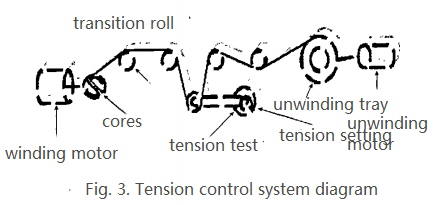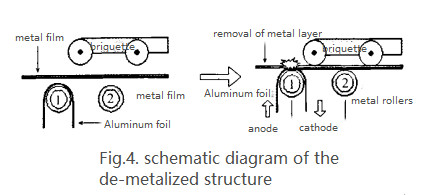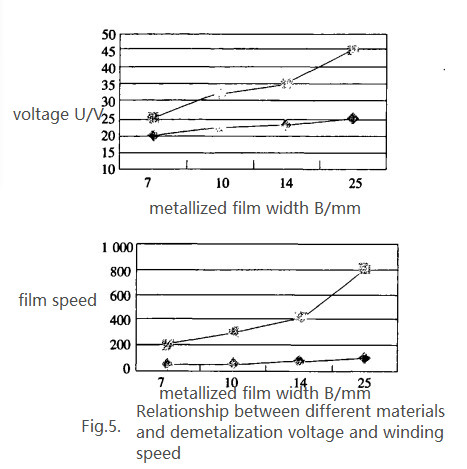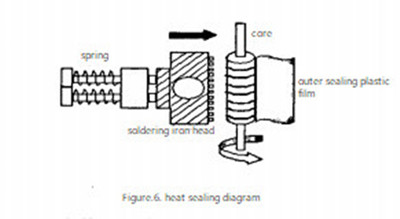In the week before, we introduced the winding process of film capacitors, and this week I would like to talk about the key technology of film capacitors.
1. Constant tension control technology
Due to the need of work efficency, winding is usually at a higher height generally in a few microns. And how to ensure the constant tension of the film material in the high-speed winding process is particularly important. In the design process we not only have to consider the accuracy of the mechanical structure, but also have a perfect tension control system.
The control system generally consists of several parts: tension adjusting mechanism, tension detection sensor, tension adjusting motor, transition mechanism, etc. The schematic diagram of the tension control system is shown in Fig. 3.
Film capacitors require a certain degree of stiffness after winding, and the early winding method is to use spring as damping to control the winding tension. This method will cause uneven tension when the winding motor accelerates, decelerates and stops during the winding process, which will cause the capacitor to be easily disordered or deformed, and the loss of the capacitor is also large. In the winding process, a certain tension should be maintained, and the formula is as follows.
F=K×B×H
In this formula: F-Tesion
K-Tesion coefficient
B-Film width(mm)
H-Film thickness(μm)
For example, the tension of film width=9 mm and film thickness=4.8μm. It’s tension is :1.2×9×4.8=0.5(N)
From equation(1), the range of tension can be derived. The eddy spring with good linearity is selected as the tension setting, while a non-contact magnetic induction potentiometer is used as the tension feedback detection to control the output torque and direction of the unwinding DC servo motor during the winding motor, so that the tension is constant throughout the winding process.
2. Winding control technology
The capacity of capacitor cores is closely related to the number of turns of winding, so the precisioin control of capacitor cores becomes a key technology. The winding of capacitor core is usually done at high speed. Since the number of winding turns directly affects the capacity value, the control of the number of winding turns and counting requires high accuracy, which is usually achieved by using a high-speed counting module or a sensor with high detection accuracy. In addition, because of the requirement that the material tension changes as little as possible during the winding process( otherwise the material will inevitably jitter, affecting the capacity accuracy), the winding must use an effective control technology.
Segmented speed control and reasonable acceleration/deceleration and variable speed processing is one of the more effective methods: different winding speeds are used for different winding periods; during the variable speed period, acceleration and deceleration are used with reasonable variable speed curves to eliminate jitter, etc.
3. Demetallization Technology
Multiple layers of material are wound on top of each other and require heat sealing treatment at the outer and interface. Without increasing the plastic film material, the existing metal film is used and its metal film is used and its metal plating is removed by the de-metalization technique to obtain the plastic film before the outer seal.
This technology can save material cost and at the same time reduce the outer diameter of the capacitor core( in ther case of equal capacity of the core). In addtion, by using the demetalization technology, the metal coating of a certain layer( or two layers) of metal film can be removed in advance at the core interface, thus avoiding the occurence of a broken short circuit, which can greatly improve the yield of coiled cores. From Figure.5, it can be concluded that to achieve the same removal effect. The removal voltage is designed to be adjustable from 0V to 35V. The speed must be reduced to between 200r/min and 800 r/min for demetalization after high speed winding. Different voltage and speed can be set for different products.
4. Heat sealing technology
Heat sealing is one of the key technologies that affect the qualification of wound capacitor cores. Heat sealing is to use high temperature soldering iron to crimp and bond the plastic film at the interface of the coiled capacitor core as shown in Figure.6. So that the core will not be loosely rolled, it’s required to be bonded reliably and the end face is flat and pretty. Several main factors that affect the heat sealing effect are temperture, heat sealing time, core roll and speed, etc.
Generally speaking, the temperature of heat sealing changes with the thickness of the film and the material. If the thickness of the film of the same material is 3μm, the temperature of heat sealing is in the range of 280℃ and 350℃, while the thickness of film is 5.4μm, the temperature of heat sealing should be adjusted to the range of 300cc and 380cc. The depth of heat sealing is directly related to the heat sealing time, crimping degree, soldering iron temperature, etc. The mastering of heat sealing depth is also especially important for whether qualified capacitor cores can be produced.
5. Conclusion
Through the research and development in recent years, many domestic equipment manufacturers have developed film capacitor winding equipment. Many of them are better than the same products at home and abroad in terms of material thickness, winding speed, demetallization function and winding product range, and have international advanced technology level. Here’s only a brief description of the key technology of film capacitor winding technics, and we hope that with the continuous progress of the technology related to the domestic film capacitor production process, we can drive the vigorous develpment of the film capacitor manufacturing equipment industry in China.
Post time: Mar-15-2022





